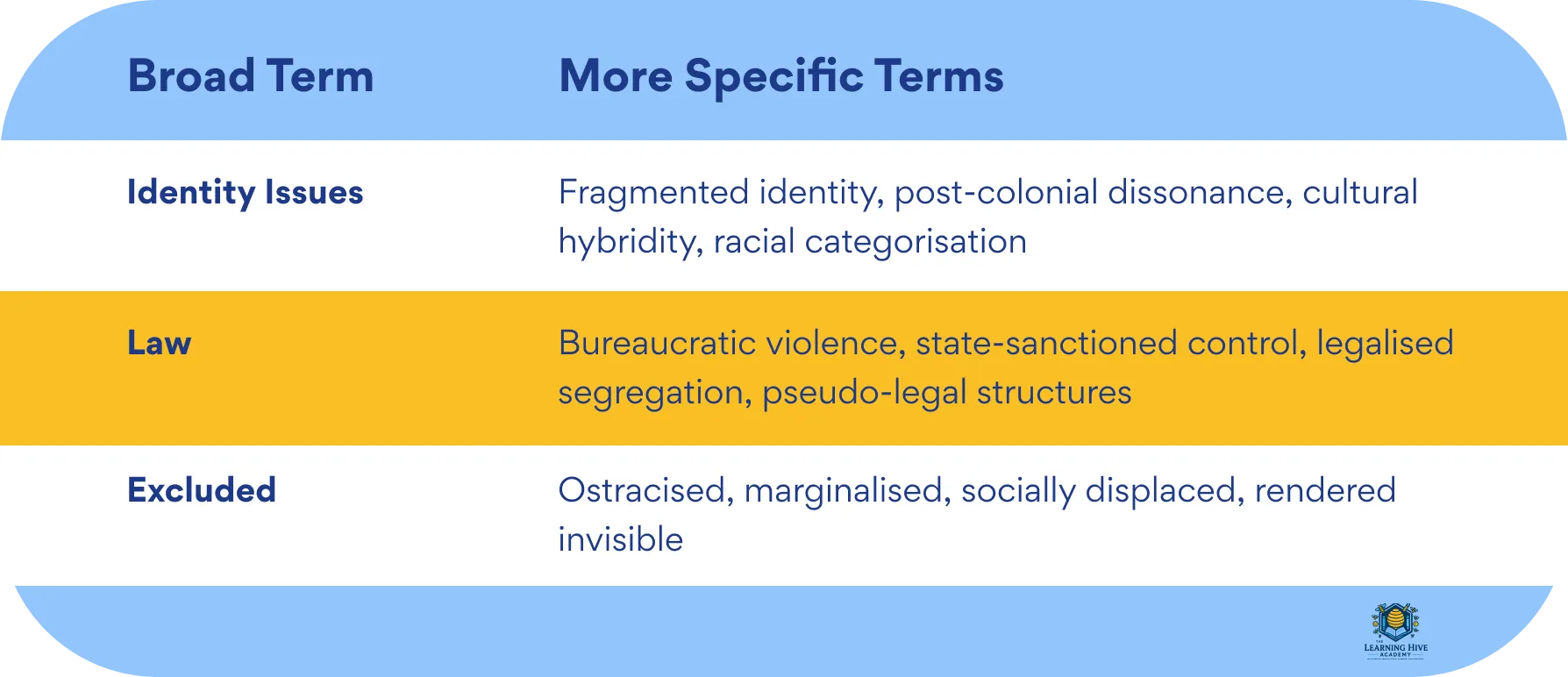The idea of VCE English assessments can sometimes be a bit daunting. Always so much you want to write, never as much time as you need and they always seem to come around sooner than you think. But there is never as much cause for alarm as you think and I’m willing to guarantee that almost everyone reading this is so much better than they think at English.
You’ve already come so far from where you started in your high school English journey. I’d like to challenge anyone reading this to go and find the earliest English essay you’ve got tucked away somewhere. I’ve done this myself and, if yours is anything like mine, you’ll be almost disgusted by what you find. Year-7-me just loved to retell the story, cling to my rigid TEEL formulas and leave my quotes just dangling, write the same basic paragraph three times and call it a complete essay. Not a pretty read and I’m sure a couple of you can relate. But, this exercise does at least prove a very valuable point: you are capable of improving at English.
So let’s start thinking about that essay you’ve got coming up again. You’ve just given yourself a nice confidence booster with that walk down memory lane, reminding yourself that you are a more-than-capable English student these days. But all you now want to do is your very best for this next essay. But how do you keep improving between now and then? After all, if you knew what you had to do to improve your English, you’d already be doing it, right? So what we’re going to do now is to have a look at what taking your essays to that next level really looks like; how you can improve your writing between now and then, whenever that might be.
So to do this, we’re going to take an already good paragraph and improve it together. Take this one, one that I conveniently prepared earlier to a Station Eleven prompt that has to do with the theme of memory/history.
Part 1: The Good Paragraph
Q: Mandel shows the importance of remembering the past. To what extent is this true?
A: In Station Eleven, the characters often find meaning from the creation of enduring legacies. Mandel demonstrates this idea through the naming of Jeevan’s son after his brother, Frank. By creating such an enduring legacy for a character who believes in the power of such legacies - 'they’re all immortal to me' - Mandel implies that characters like this are able to achieve meaning and fulfilment by preserving these legacies. Mandel also uses the character of Miranda to highlight the importance of legacies to provide meaning where Miranda lacks it in her day-to-day life. Even though Miranda’s life is left incomplete by her sudden death, the beauty in the scene of her death suggests that a sense of fulfilment has been achieved despite the emptiness of her life relative to other characters: 'its extravagant sunsets and its indigo sea'. Hence, the meaning in her life comes from the legacy that she creates from the art she makes in her 'independent' life. This is contrasted against the character of Arthur, whose legacy does not influence any events in the post-flu world, because of his failure to create legacy or meaning beyond his day-to-day life. Further, Arthur’s death in the hectic Elgin Theatre has far less beauty than that of Miranda, implying less fulfilment in his life. Therefore, Mandel uses her text to demonstrate the value of creating legacies that allow others to remember the past.
Let’s call this our good paragraph. I’ve modelled this off of an essay I found from my Year 10 self, as happy as Year-10-me would have been with this performance, it’s far from perfect. But, it is a very functional paragraph that does all that a paragraph really needs to do. It introduces an idea, justifies it with evidence, links back at the end and doesn’t waste too much time retelling the story. So now we get to the fun bit: we’re going to take this already good paragraph, and turn it into a better paragraph.
So how do we make a good paragraph better?
Well, for a start, we can integrate our quotes so that the paragraph reads better. You’ll see in just a second how much of a difference this can make. This is something I learnt to do between Years 10 and 11. Other improvements that could be made include answering the prompt more directly and using some of the language of the prompt within our answers. So let’s change this and see now what these small differences do to our paragraph.
Part 2: The Better Paragraph
Q: Mandel shows the importance of remembering the past. To what extent is this true?
A: In Station Eleven, the characters often find meaning from the creation of enduring legacies that allow others to remember the individuals who came before. Mandel demonstrates this idea through the naming of Jeevan’s son after his brother, Frank. By creating this symbolic memorial for a character who believes that such legacies can allow individuals such as actors to become 'immortal', Mandel implies that characters like this are able to achieve meaning and fulfilment through their legacies. Furthermore, Mandel also uses the character of Miranda to highlight the importance of creating a legacy through one’s art to provide meaning where Miranda lacks it in her day-to-day life. Although abruptly killed off in the middle of the text, Mandel imbues her death with a certain beauty through its 'extravagant sunsets and indigo sea'. In doing so, Mandel provides a sense of completion about Miranda’s life and suggests that a sense of fulfilment has been achieved despite the emptiness of her life relative to other characters. Hence, the meaning in her life comes from the legacy that she creates from the art she makes in her 'independent' life. This is contrasted against the character of Arthur, whose legacy does not influence any events in the post-flu world, because of his failure to create legacy or meaning beyond his day-to-day life. Further, Arthur’s death in the hectic Elgin Theatre has far less beauty than that of Miranda, implying less fulfilment in his life. Therefore, Mandel uses her text to demonstrate the importance of creating legacies that allow others to remember the past.
There we have it. The paragraph has been rewritten based on the ones I wrote in Year 11 and we have the first signs of improvement. The topic sentence now references the ‘remembering the past’ aspect of the prompt. The linking sentence now uses the ‘importance’ part of the prompt. All of the same quotes are used but are now integrated (check out How To Embed Quotes in Your Essay Like a Boss if you need more help with this).
We’ve made sure not to have more than one sentence starting with Mandel (a small nitpick but still a nice addition). It flows better. It answers the prompt more directly and suddenly we have a better paragraph. Year-11-me has shown improvement and with this comes better scores and more confidence: something that’s very important for success in English. If you’re confident and proud of what you’re writing, then you’ll have higher marks and, even better, more fun!
We haven’t changed much and the paragraph is already better. But it’s not my best paragraph. Between Years 11 and 12, I learnt even more things. I was taught to write about not only the world of the text but also the world around us that we and Mandel live in: you’ll notice that this better paragraph talks more about ‘characters’ that live ‘in the text’ whereas my best paragraph would talk more about the text in the context of the world you and I live in. I learnt to make my topic sentences more abstract and broad so that they relate more to our own world and less to the world of the text and remind whoever’s assessing that my ideas apply to everyone and not just within the texts. I learnt to respond more directly to different types of prompts (Discuss, To what extent is this true?, How does Mandel… and others) and I learnt to be more direct in discussing the views and values of Mandel (what she likes, what she doesn’t like, what she wants to see more of in the world)
So let’s apply some final changes, and see what our paragraph looks after two more years of refining English. This final paragraph is almost exactly the same as one I wrote in timed conditions before my final exam.
The Final Part: The Best Paragraph
Q: Mandel shows the importance of remembering the past. To what extent is this true?
A: Mandel explores the importance of legacies, not only as sources of meaning for their creators, but also for their roles in allowing others to remember the roles of those who came before. Such an idea is explored through the naming of Jeevan’s son, securing the legacy of Frank. By affording such a permeating influence to an individual who writes of and appreciates the 'immortal[ity]' of long-dead actors, Mandel implies that an appreciation of the inherent value in a legacy and its ability to influence future events is a key quality in individuals. Furthermore, Mandel uses the character of Miranda to highlight the importance of creating a legacy that outlives oneself to provide meaning. Although abruptly killed off in the middle of the text, Mandel imbues her death with a certain beauty through its 'extravagant sunsets and indigo sea'. In doing so, Mandel provides a sense of completion about Miranda’s life and suggests that a sense of fulfilment has been achieved despite the emptiness of her life relative to other characters. Hence, Mandel suggests that the meaning in Miranda’s life comes from the legacy that is the art she makes in her 'independent' life that continues to influence events and allow others to remember the past long after her death. Mandel provides contrast through her exploration of Arthur, whose legacy does not influence any events in the post-flu world because of his failure to create legacy or meaning beyond his day-to-day life. Further, Arthur’s death in the hectic Elgin Theatre has far less beauty than that of Miranda, reinforcing Mandel’s view that individuals who forfeit control of their own legacies, as Arthur does, lead far less completed and fulfilled lives. Therefore, Mandel highlights the immense importance of creating legacies that allow others to remember the past and encourages greater appreciation of the value of legacies in contemporary society.
So, two years later, and we’ve got what is still essentially the same paragraph, just brushed up to an even better, or best, standard. So if we’re using the same evidence, exploring the same characters and introducing the same ideas, why is this paragraph better than the last two?
Well, if you study the topic and linking sentences, they discuss the concept of a legacy being a means of allowing others to remember the past and the importance of such a thing and everything in-between links this concept to the text. 'Mandel highlights the immense importance' represents a subtle but nice nod to the wording of the prompt by giving an ‘extent’ to which Mandel ‘shows’ or highlights. Every piece of evidence is discussed in reference to what Mandel believes about the world around us and how individuals should act in modern society.
And there’s something very nice that we can now reflect on. This paragraph has gone from good to much better without having to introduce any new ideas. There are no overly complex interpretations of the text, we’ve just taken the same skeleton of a paragraph and made it look better without changing its real substance.
And one of the wonderful things about making efforts to improve the quality of your writing is all the confidence that comes with this, whether this be from getting better at discussing views and values, learning to integrate your quotes or any achievement like this. I know that my confidence surged as my English got better and, as I got more confidence in my writing, I got more confidence in what I wrote about. My interpretations of the text became more and more obscure and a bit whacky at times and I had fun writing about these things. If you improve your writing, you’ll improve what you’re writing about which will mean you’ll have more fun writing and the cycle of improvement will just continue.
So to cap off, I thought it might be nice to have a checklist of sorts that you might be able to put against your own writing.
What’s the next step I could take in improving my English?
- Are all my quotes properly integrated? (Hint: if the sentence doesn’t make sense without quotation marks, the answer is no)
- Have I got more than a couple of sentences starting the same way or could I vary my sentence structure a bit more?
- Have I explicitly used some parts of the prompt in my own writing so that I can directly answer the question in my essays?
- Am I writing about both the world of the text and the world we live in outside of the text instead of just the characters and relationships within the text?
- Are my topic and linking sentences describing a concept that relates to the prompt with everything in-between relating this concept to the text? (I found this a very useful way of thinking of paragraphs)
- Is all of my evidence being discussed in relation to the views of the author?
- Does my essay/paragraph explain what the author would like to see more of/less of in modern society based on what is explored in the text?
- Is my essay/paragraph specific to the exact wording and type of prompt?
And these are just some of the improvements that could be made. I’m sure each of you could ask teachers and past students and find many, many more tips on improvement. Just as long as you’re thinking about what the next step in your English might be, then you’re already headed in the right direction. So good luck and happy writing!





.webp)





.jpg)